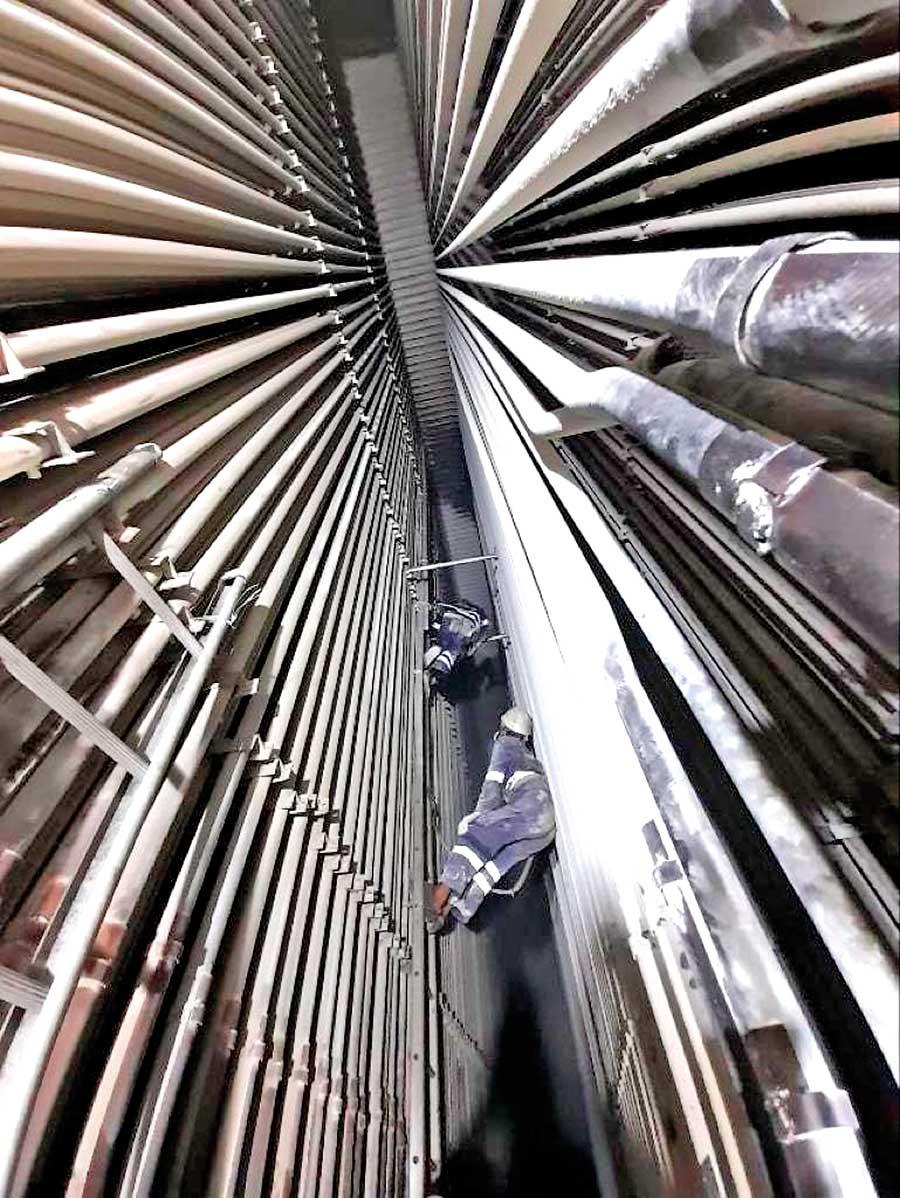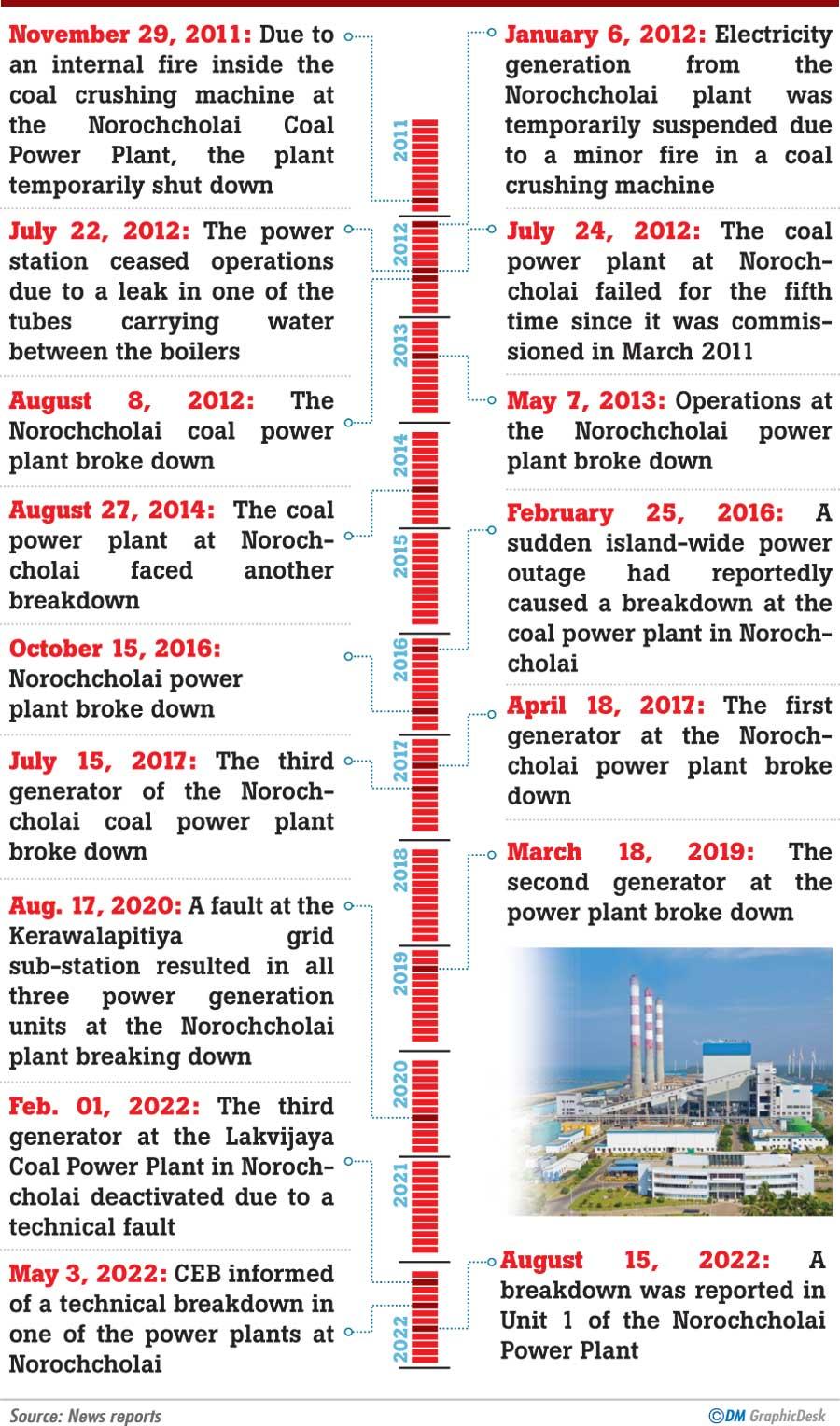29 Aug 2022 - {{hitsCtrl.values.hits}}

CEB authorities have stated that if an adequate amount of rainfall is experienced, and if no other issues in power plants occur, reduction of power cuts would be a possibility
- The second (Unit 02) generator of the Lakvijaya Power Plant undergoing a major overhaul has caused a loss of 270 MW to the national system
The entire maintenance process is not given to CEB, and the Chinese dominate the process
Extended power outages plagued the nation earlier this year since it was unable to import the fuel needed to generate electricity. However, as monsoon rains have increased hydropower production, the situation has improved. The state, which promotes renewable energy as a potential remedy for its power problems, claims that the law must be changed in order to hasten project clearance and execution.
to generate electricity. However, as monsoon rains have increased hydropower production, the situation has improved. The state, which promotes renewable energy as a potential remedy for its power problems, claims that the law must be changed in order to hasten project clearance and execution.
Thanks to the southwest monsoons, the nation only faced one-hour power cuts from August 5. However, with the breakdown in the Lakvijaya Coal Power Plant, more commonly known as the Norochcholai Coal Power Plant (NCPP), the country’s scheduled power cuts were extended to three hours.
On August 15, Sri Lanka’s Minister of Power and Energy, Kanchana Wijesekera, announced that there had been a breakdown in Unit 1 at the Norochcholai Power Plant. Three generators make up the Norochcholai Coal Power Plant, each generating 300 MW, and together they produce 900 MW for the National Grid. Generator Two had already been taken out of service for crucial repair on August 15 when Generator One malfunctioned.
As the second (Unit 02) generator of the Lakvijaya Power Plant is undergoing a major overhaul at present, its total capacity of 270 MW has also been lost to the national system. Therefore, the national grid has lost 540 MW. (30 MW from each unit is utilised for the internal activities of the power plant). According to the CEB, the engineers had to wait a week to reach the generator until it cooled down.
When the Daily Mirror spoke to CEB spokesman Andrew Nawamani, he said that by the following Monday (August 29), it would be possible to restore Generator One and add it to the National Grid. However, he was uncertain whether the power cuts would be reduced to one hour, although Generator One would be added to the system at the earliest. Furthermore, Nawamani said that if an adequate amount of rainfall is experienced, and if no other issues in power plants occur, reduction of power cuts would be a possibility. He also said that this is the second time that Generator One had malfunctioned this year due to low maintenance. In addition, he said that the staff handling the repairs comprise Chinese and Sri Lankan workers in equal propotion.
CEB issues press release
Issuing a press release on Monday, the CEB further explained the situation of the maintenance of the Boiler in Unit 01 of the Lakvijaya Power Plant. “This boiler, which is part of the main equipment of a coal power plant, can produce 1,025 tonnes of steam per hour when operating at maximum capacity; for this, about 110 tonnes of coal must be burned. The water passing through the boiler tubes absorbs the heat generated by coal combustion and turns into steam. This steam is made to absorb heat further in the boiler to become superheated and pressurised steam. When this steam is released into the turbine, it has a pressure of 17 Megapascals, 167 times the atmospheric pressure, and a temperature of about 540° C.
“This process takes place in a completely closed system. The temperature of the coal-burning furnace is very high, around 1,000° C, so no person can enter it or see the inside. On the morning of the 15th, an alarm signal was observed in the Boiler Leak Detection System to monitor the condition of the boiler after observing the changes in the Main Steam Pressure and water flow (Feed Water Flow). At the same time, a loud noise was heard near the boiler. Accordingly, after identifying a steam leak in the boiler and informing the System Control Centre, the 1st generator was stopped for maintenance.
“After the 1st generator was stopped on the 15th, the maintenance department reached the place on the 20th and started the maintenance work. As of August 22, seven days later, the temperature of the pipes (metal temperature) is 65° C. The maintenance work of the fully enclosed site with narrow space is already being carried out rapidly, and efforts are being made to add the 1st generator to the system as soon as possible,” the statement read.
CEB’s United Trade Union Alliance Convener Ranjan Jayalal speaking to the Daily Mirror said that it would at least take two more weeks to add generator one to the National Grid. He also added that the third generator, which is currently functioning, also has several defects due to lack of maintenance. “It is not the fault of the workers. Once generators one and two are added to the system, it is a must that the third generator must undergo a major overhaul; if not, power cuts are likely to last over three hours. Moreover, when the CEB authorities speak to the media, they must be responsible of what they convey. It was said that Unit 1 could be restored within three days; such misinformation should not be disseminated,” he added.
Furthermore, he said that the entire maintenance process is not given to CEB, and the Chinese dominate the process. “Since the beginning, we have given warnings regarding this power plant. It has been a troublemaker since its first days; and more than functioning it is under repair. Our workers are talented and active; it is only with their energy that we are operating the power plant at least up to this capacity. Even the rubber bush must be brought from China, but our workers are finding solutions to any problem that arises and are running the power plant to its maximum capacity. But when a major overhaul is needed, it can only be done according to the whims and fancies of China,” he underlined.
Jayalal added that the way in which the power plant was constructed was the primary cause for trouble. “Even in China, when they come up with power plants, they build power plants with 50 – 80 MW capacity. But we wanted bigger ones, and currently, we have three generators of 300 MW each. So initially, we proposed to have nine power plants with 100 MW each. If we did that, we would not be facing extended hours of power cuts because, even if one faces a breakdown, there are 800 MW still running in the country. This was a wrong decision taken by the CEB,” he added.
Furthermore, he revealed that the engineers working in Norochcholai are facing numerous health hazards due to the dust released by burning coal. “Engineers in Norochcholai, Victoria and Samanalawewa do not have comfortable lives as the engineers in Colombo. The lifespan of engineers working in the coal power plant is now reduced to 50 years due to inhaling harmful gases. Excessive heat is experienced in the power plant premises and on top of all the sound pollution. All together has affected the nervous system of the workers and the people living in the neighbourhood,” he said.
In addition, he said that the Norochcholai power plant is one strategy used by the Chinese to invade our country. “In the same manner the India-based conglomerate Adani Group took over two wind energy projects, the Chinese will dominate the coal power plant. The Norochcholai area has turned into a Chinese village. Starting from the noodles packet, they import everything they need, and they have settled down with their families. The Chinese are looking forward to grabbing the coal power plant amidst the crisis,” he said.
Tracing back to the past of the Norochcholai power plant, former President Mahinda Rajapaksa revived the long-stalled plan for Sri Lanka’s first coal-fired plant in Norochcholai back in August, 2005, while the civil war was still raging. There appeared to be few available power production choices for Sri Lanka at the time. With a few gas-fired facilities for peak loads, the majority of the nation’s energy generating capacity was reliant on pricey oil-fired power plants. Therefore, the CEB chose coal. A proposition presented by the Chinese government looked too good to pass up.
The projected power plant’s first 300 MW unit received a US$450 million loan from the Export-Import Bank of China at a discounted interest rate of 2% on two-thirds of the loan and 6% on the remaining balance. The China Machinery Engineering Corporation (CMEC) designed and constructed the plant before turning it over to the utility because the CEB lacked expertise with coal-fired power plants.
More than half of the new coal power plant capacity added globally last year came from China, demonstrating how heavily one nation supports one of the worst contributors to climate change. A “phasing down” of coal was promised by over 200 nations at the COP26 climate meeting last year.
In fact, the number of coal-fired power plants worldwide is increasing as new constructions outnumber the closing of outdated plants. Asia is where new coal power plants are being built the most, with China accounting for most of the projects.

25 Nov 2024 2 hours ago
25 Nov 2024 3 hours ago
25 Nov 2024 3 hours ago
25 Nov 2024 5 hours ago
25 Nov 2024 5 hours ago